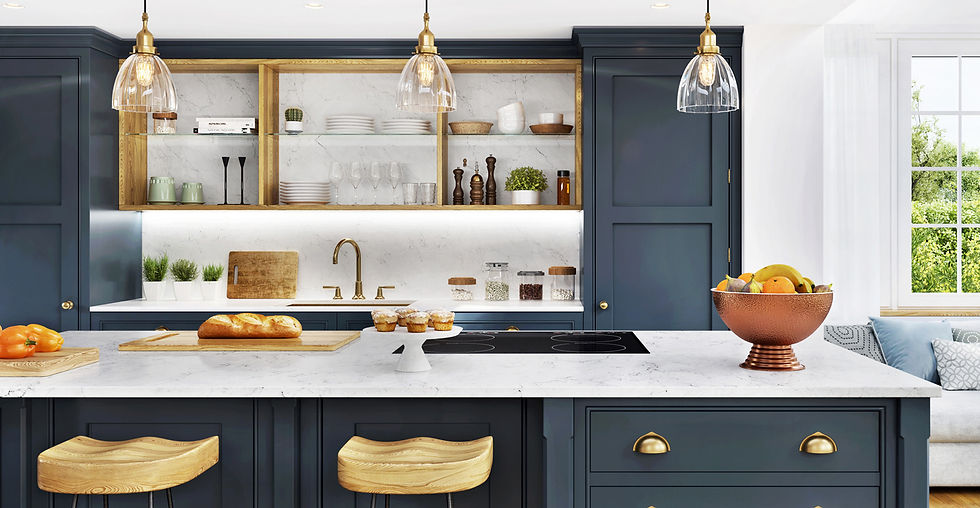Step into the light - dos and don’ts of roof lights for single storey extensions
- Julie Bliss

- Jul 8, 2022
- 3 min read
Updated: Jul 12, 2022
With the race for space, home working and subsequent increase in people making the most of permitted development rights, single storey rear and/or side extensions have really come into their own. How best to maximise natural light to these additions?
With single storey rear extensions, most people will go for the standard box on the back variety to keep costs to a minimum, and there is nothing wrong with that. However, you might want to think about having a little bit of fun by creating a gable (which can also house a clerestory window for extra light) or pitching the roof from side to side instead of back to front (but you need to think about light direction for this option). The most important element on rear and side extensions, though, is how to maximise the natural light to the new addition and the rooms behind it. When you stick another room on the back or side of your existing house, you are basically taking away all the light from the rooms that were originally there (and had windows to the outside).
These rooms are now essentially “internal”, so in order to make sure that you provide them with as much natural light as possible, you need to maximise the light coming into the rear extension. Simply putting windows or doors on the back will not do this. You need to use the roof as well. This is where roof lights come in.
Types of roof light
There are various different options when it comes to roof glazing and three basic types of ways to glaze your roof: Openable roof windows
These are single units flush with the roof and generally reachable when you’re standing. They are great for all single storey extensions with a pitched roof (and loft conversions). They increase the light by 40% due to the angle and also provide much needed ventilation if they’re opening ones. They are much less likely to have any leaks or issues due to the way they are constructed - within the roof rafters, so no additional construction is needed. The most popular and almost generic brand is Velux. Static or non-openable roof lights
There are single or modular glass window units that are usually built with an upstand or kerb (so they pop up from the roof) in order to be water tight. These can be flat or domed and opening ones don’t need as much gradient as opening ones. You can also get roof lights for completely flat roofs.
Some large roof lights or skylights, such as roof lanterns, may require additional construction of the roof itself (ie. they’re not built within the rafters) in order to house the unit(s), which can be a lot more complicated and expensive.
It’s also worth mentioning that if you are going for an extension within permitted development, the roof lights cannot be over the 4m maximum roof height, so if you are going for a roof lantern, the rest of the roof will need to be lower in order for the top of roof lantern to be under 4m above ground.
Dos and don’ts of roof lights
Do check on the gradient of your roof. This can affect your roof light options.
Do keep it simple! Skylights and lots of glass can look great, but can also cause a headache if you overcomplicate things. This is where roof windows and roof lights are best as they are generally designed to fit within the roof rafters.
Don’t put in too much unnecessary glass - you’ll be forever cleaning it and it can cause issues with the temperature and glare within the room. Definitely don’t just have a glass roof like a conservatory or orangery. Conservatories that are for occasional use are one thing; having an entire glass roof over your kitchen is quite another!
Bear in mind that the more glass you have, the noisier the room will be in a downpour. There is not really anything you can do about the rain, or how it sounds on roof windows. And we do get a fair bit of it. It is England after all! While they can be a nice feature, roof lanterns and other similar multi-panel roof lights are made up of lots of sections, increasing potential for leaks.
Do be practical. Will your glass be accessible for cleaning? Passing birds love a roof light…!
Do choose high spec glass that both minimises UV and is also energy efficient.
Do consider your interior lighting options and how lighting will work around your fenestration. Spotlights and pendants are easy to distribute around roof lights and roof windows, but roof lanterns, for example, will take up the whole central area of your room’s ceiling, so you’ll need to be creative about lighting your dining area for example.
For more information or to request a consultation, contact Julie: julie@blissinteriors.me.uk.













